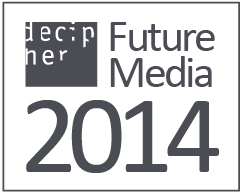Click Here To See the Overview of FutureMedia 2014 Programme
 For the Q3 wave of our Future Media Research Programme in 2014 we have been looking at the evolution and convergence of the TV and video advertising industries. The big background theme we’ve been exploring is how these two industries, their technologies and their very different business practices will gradually come together at a time of great change and convergence across screen based media.
For the Q3 wave of our Future Media Research Programme in 2014 we have been looking at the evolution and convergence of the TV and video advertising industries. The big background theme we’ve been exploring is how these two industries, their technologies and their very different business practices will gradually come together at a time of great change and convergence across screen based media.
At the current point in time it feels like more of a collision than a convergence, with the two industries squaring up over the comparative quality of their data, audience analysis, targeting, addressability, ad distribution and insertion systems. Claim and counter claim between the two industries indicates that we are not comparing apples to apples at the moment, and that both industries start from a very different world view. The TV is still very much an ‘audience’ based media – celebrating shared or group viewing experiences on the big screen. The web is still a ‘viewer’ based media – celebrating the individual experience on personal devices. The TV ad industry still tells a better story about capturing and exploiting mass culture in a single country. The web tells a better story about managing global media budgets for global clients across multiple territories. They are not incompatible stories, but the market is struggling to reconcile them.
Technical systems convergence and the drive towards web and cloud systems across all industries heralds the potential for these worlds to converge. This could bring with it a revolution in the commercial aspects of sales, pricing, deal structure and a corresponding shift in industry power. However, the cultural and organisational barriers to this are huge. Our 2014 review is intended to audit and provide explanations for all these aspects of ad evolution and most importantly, put them into the context of a rapidly evolving TV industry.
Exploring The Wider TV Tech Context
The context is, in many ways, the hardest to pin down. We all seek simplicity in life but for the foreseeable future, the context for TV ‘distribution and consumption’ is only get more complex. There are so many things changing that it can be hard to keep up and it is clearly a much broader phenomenon than just the convergence of different ad-tech systems. In the TV industry there are wider  changes that may or may not affect advertising – such as video quality standards. The TV industry is already halfway through an upgrade from SD to HD and this may still have a few years to run – although its not clear that all channels and all content will make the switch. It is likely that both standards with be with us for the foreseeable future. Now a third standard, Ultra HD is being discussed, and it is highly likely that the coming generation of set top boxes will be operating with channels using all three standards. For advertising creatives there are opportunities as well as new costs to consider. From an ad-tech point of view this may slow the shift to IP (because UHD file sizes are so big). Our report lays out the potential implications of the arrival of UHD for both the creative and the distribution aspects of the advertising industry.
changes that may or may not affect advertising – such as video quality standards. The TV industry is already halfway through an upgrade from SD to HD and this may still have a few years to run – although its not clear that all channels and all content will make the switch. It is likely that both standards with be with us for the foreseeable future. Now a third standard, Ultra HD is being discussed, and it is highly likely that the coming generation of set top boxes will be operating with channels using all three standards. For advertising creatives there are opportunities as well as new costs to consider. From an ad-tech point of view this may slow the shift to IP (because UHD file sizes are so big). Our report lays out the potential implications of the arrival of UHD for both the creative and the distribution aspects of the advertising industry.
Irrespective of the video standard used, distribution of linear channels is going through a similar fragmentation. Broadcast channels are still the mainstay of TV programme distribution (over satellite, aerial and cable) but, UHD not withstanding, we now have a spreading network of Unicast and Multi-cast IP delivered channels arriving at the set top box (STB) . BT Sport is the first major multi-cast IP channel (if you receive it via YouView that is). Boxes which can receive both types of linear IP channel, as well as broadcast, and present them via channel slots on the EPG are now common in the Freeview market and beginning to appear in pay TV boxes. The ultimate landscape for channel distribution will be a combination of all types of broadcast and IP. For the web-based advertising-tech world, however these channels represent the Trojan horse into the set top box for the programmatic ad systems now beginning to dominate web video. The big questions are which ones, and what are the commercial deals they will do to get their systems into the boxes. Our Q3 review looks at the route for programmatic ad systems into linear TV and set top boxes and examines who is positioned to exploit this new advertising opportunity and whose business is threatened. We also look at how the distribution choices affect how new ad systems may work. We look at Sky’s Ad Smart addressable ad system and show how it might work with all the channel types described as well as explaining its role in the broader context for TV addressability and linear ad innovation.
At the same time as simple linear channels are turning to IP, new ‘converged’ broadcast and web channels, which merge the signals into combined interactive linear channels, are being developed. Building on the BBC’s recent red button activity, players like Arqiva and Simplestream have created a new generation of interactivity within linear. Outside the BBC, commercial channels are now looking at how web and broadcast convergence could deliver new advertising formats within a linear channel’s content. This could take a number of formats from next gen red button, through to Spotify style thematic VOD channels (as we once had in innovative TV platforms like Homechoice TV). Within each of these new channel formats lies the potential for advertising to be addressed, inserted and measured in a slightly different way. We audit these possibilities and explain the commercial possibilities.
As well as ad innovations around linear channels, the TV industry knows that there are also more innovations to come in the way that STBs deliver content to viewers. There will be a continued blurring of the functionality of  personal video recorders (PVRs) and on-demand (OD) systems with the difference between PVRs and OD is increasingly just a commercial/legal one, not a technical one. This blurring has two aspects – firstly, recording capacity is beginning to move to the cloud (eg Magine and other nPVRs). How resident advertising in recorded programmes is treated in these recorded formats and the ability to swap out advertising, or use data to target within these formats is now being explored by third party providers. Secondly, PVRs are increasingly being used to host on-demand programming (eg pushVOD on Sky, or DishNetwork’s Primetime service) – the potential for advertising to be inserted into these programme formats at the box or hosted locally has been solved technically but now needs commercial solutions to be developed. Our study examines the challenges behind these solutions and looks to the players that could exploit them. What has become clear is that the STB/PVR is evolving into a more powerful media server able to deliver a home-wide TV experience. Within this connected home vision, the box will also increasingly contain an ad server. The first manifestation of this new ad server STB is the Sky Ad Smart solution. We pull out the potential of these formats, explain the technical and commercial mechanisms and explore how ‘Ad Smart’ style systems will work in this context. Most importantly, we address the question of who can deliver this functionality outside of the Sky customer base, and into the free-to-air market.
personal video recorders (PVRs) and on-demand (OD) systems with the difference between PVRs and OD is increasingly just a commercial/legal one, not a technical one. This blurring has two aspects – firstly, recording capacity is beginning to move to the cloud (eg Magine and other nPVRs). How resident advertising in recorded programmes is treated in these recorded formats and the ability to swap out advertising, or use data to target within these formats is now being explored by third party providers. Secondly, PVRs are increasingly being used to host on-demand programming (eg pushVOD on Sky, or DishNetwork’s Primetime service) – the potential for advertising to be inserted into these programme formats at the box or hosted locally has been solved technically but now needs commercial solutions to be developed. Our study examines the challenges behind these solutions and looks to the players that could exploit them. What has become clear is that the STB/PVR is evolving into a more powerful media server able to deliver a home-wide TV experience. Within this connected home vision, the box will also increasingly contain an ad server. The first manifestation of this new ad server STB is the Sky Ad Smart solution. We pull out the potential of these formats, explain the technical and commercial mechanisms and explore how ‘Ad Smart’ style systems will work in this context. Most importantly, we address the question of who can deliver this functionality outside of the Sky customer base, and into the free-to-air market.
At the same time, more web like short-form OD content – advertising and programming – has arrived at the set top box. Sometimes this opportunity is built into TV versions of the YouTube app (as with Smart TV), but increasingly short-form is being integrated into the wider TV experience (eg the EaselTV/Brightcove hosted-video ad formats on VirginTivo, or the Adconian/Yume short form ads on Smart TVs). This is not new, and anyone who saw the original US TiVo boxes installed at iBurbia in 2005 would have seen hosted advertising from Buick and Charles Schwab promoted via banners on the Tivo EPG and played out through the core system. We are now seeing the second coming of this ‘integral short-form’ format. However, its role, value and pricing are yet unresolved. Our Q3 report offers pointers to their commercialisation.
The arrival of banners and display into EPGs shows that consumer journeys into and around these new formats, are also undergoing a convergence revolution. New EPGs are increasingly being written in HTML5 and beginning to behave like web pages in the way they manage content. This includes the potential for banners and other promotional activity. As we have seen on Virgin Tivo, this means having the ability to present pictures, animation other short-cuts to the various video ad formats hosted in the system. The EPG has the potential to emerge as the most important web interface in the TV landscape, with the ability to move viewers seemlessly between content and advertising formats. Our report audits and explains current examples and highlights more to come.
Stepping slightly away from the set top box, we are beginning to see the emergence of a TV ecosystem that links the main box system more convincingly to apps on mobile devices and Smart TVs. We have had a couple of years of tentative second screen innovation – from both programme makers and from TV platforms – some of them with advertising concepts integrated with content. But the arrival of GoogleChromecast has highlighted the potential for a much more sophisticated interaction. We look at how the next generation of second screen will help the TV industry blend advertising, data and functionality aimed at both an individual AND an audience into a combined ad ecosystem in the home. Our report examines the different content models emerging on second screen and shows where power lies in the advertising models that they bring.
Summary – The Big Themes
Behind these specific types of innovation and change there are a set of unifying themes and innovation strands that have emerged and are examined in the Q3 report. In particular, the arrival of actionable data in the TV world has kicked off a huge wave of innovation around targeting and addressability. It is likely that this will manifest itself in every aspect of the new TV advertising world described in the report. What is initially clear is that the data available to the TV industry is very different to that which is available in the web ad-tech world. These differences hint at opportunities for a converged, complementary approach if handled correctly and we point out routes to achieve this.
Secondly, the growth in the role of time-shifted and on-demand content, of all types in the TV consumption mix, has had a profound impact on the competitive landscape and the related ad industry. The ad innovation around on demand has been focussed to date on the web players developed by broadcasters. Our report lays out the evolution of these formats as web and TV systems merge and the control and functionality of these formats shifts in the value chain.
Thirdly, the growing disconnect between ‘national’ and ‘international’ capabilities within TV players, advertisers, ad-tech companies and media agency groups is a growing concern. The open standards and economies of scale of the global ad-tech world contrasts positively with the closed, proprietary TV advertising systems in place around broadcast. Apart from the fact that the TV ad sales process can seem antediluvian to the web tech community, it is hard to see how single marke t broadcasters, or even platforms like BSkyB, are going to compete with the global ad-tech scale and development power of the global media agency conglomerates. However, the nuanced ’local market’ and ‘audience segments’ available through broadcast are difficult to repeat with automated systems and are where single market broadcasters earn their stripes. Within these single markets, the mass, synchronous delivery of high quality TV ad campaigns to a national audience segment is a broadcast capability that the web has yet to replicate. We explore the arguments for both sides.
t broadcasters, or even platforms like BSkyB, are going to compete with the global ad-tech scale and development power of the global media agency conglomerates. However, the nuanced ’local market’ and ‘audience segments’ available through broadcast are difficult to repeat with automated systems and are where single market broadcasters earn their stripes. Within these single markets, the mass, synchronous delivery of high quality TV ad campaigns to a national audience segment is a broadcast capability that the web has yet to replicate. We explore the arguments for both sides.
Our report at simplest is an audit and exploration of the current state of ad-tech convergence as it affects all TV and web advertising players. On a wider note it explores the trends that are driving the changes in tech and commercial market structure. Finally, it provides insight and recommendations for all parts of the TV and video value chains.
Nigel Walley – @nwalley
Note: The Q3 Report is to be published in the first week of August. Details on how to buy the Q3 Report can be found on the Decipher web site here
